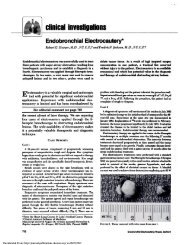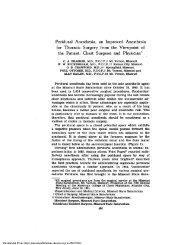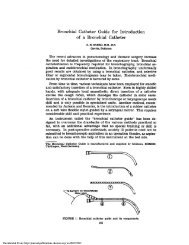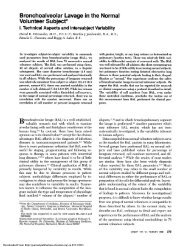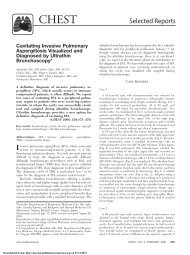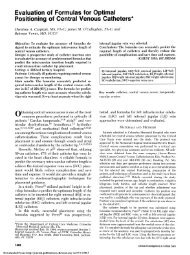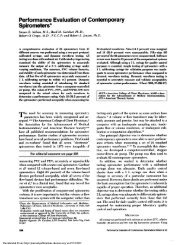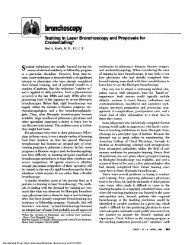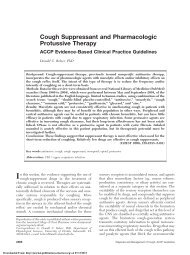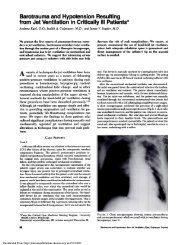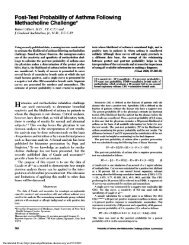Are Pulmonary Capillaries Susceptible to Mechanical ... - Journal
Are Pulmonary Capillaries Susceptible to Mechanical ... - Journal
Are Pulmonary Capillaries Susceptible to Mechanical ... - Journal
You also want an ePaper? Increase the reach of your titles
YUMPU automatically turns print PDFs into web optimized ePapers that Google loves.
<strong>Are</strong> <strong>Pulmonary</strong> <strong>Capillaries</strong><br />
<strong>Susceptible</strong> <strong>to</strong> <strong>Mechanical</strong><br />
Stress?*<br />
Oc/i/u’ A. ltIat/uiu’u-Co.sts’//o, P/iD.; uuud Johuu B. %Vc.s’t, \I.D., P/u.D.<br />
T tie extreme thinness of the puuluimonarv blood-gas<br />
barrier has lomig beesm recognized. Its fact. large<br />
portiouis of the batrrier are so thin that they’ asre aut the limit<br />
of time power of resohsutiomi of the light microscope. It is<br />
omihy’ with the advent of electromi umiicroscopv that tise<br />
cellular strumctcmre of the blood-gaus barrier wats ehumcidasted.<br />
Forty years asgo. Fraunk Low’ publishiedl time first electrous<br />
msmicreigraphms of the luumsg parenchsvuiia in labora<strong>to</strong>ry asmi-<br />
mats asmid lmuumauis, and cleuiionstrated time presemice of as<br />
comitiustuotus epithseliall limming cif the alveolar \vall. Since<br />
theum, the reusuarkable thiinness of the pulnieinarv blood-<br />
gas harrier lists usmaimily’ beemi viewed in terms of the<br />
clmaracteristics tlmat make it so effective for diffusioum.<br />
Respira<strong>to</strong>ry gases are transferred! by isassive diffusiomi and<br />
therefore aut as given partial pressure cliffereuice across the<br />
harrier, increasedi passage cif gasses occurs with greater<br />
sumrfauce atreal aumd reduced tissue tlsickmiess, according <strong>to</strong><br />
the Fick law of diffusion.<br />
In time Iiuuimatus Iuung, the alveolamr surfatc’e area is very<br />
large (sup <strong>to</strong> 150 mmm2), approximately half of which is oui tIme<br />
thu side of the blood-gass barrier with a thickness of omihy<br />
0.2 <strong>to</strong> 0.4 tmii.1 As noted elsewhere,’-4 however, there is<br />
evidence of diffusion-limitation of 0, uptake imi elite<br />
athletes chmring ussaximaul exercise,5-5 suggesting that the<br />
blood-gas barrier c’oumld umot be amsv thicker without feur-<br />
titer himmiitautiouis of 0, uptake duuring heavy exercise. At<br />
the sausme tiusme, the pulmonary blood-gas harrier must be<br />
vemv strong tdi maintaimi its structuraul imitegrity in spite of<br />
its extreme thinness, and <strong>to</strong> withstand the high wall<br />
stresses ciurimig iustense activity. The stremigth of the<br />
blood-gas barrier.4 and the pathiophmvsiologic conditiomis<br />
where it fails hecausse of stress fasilumre of putmimonaury<br />
capillaries,’- have umot been previd)ushy recognized.<br />
STuSENGTIt OF Bu.ooD-CAs BsRusuEB ANu) FoRcEs ACTING<br />
ON’!’ lIE Auxeou,.Aus WALL<br />
There is evidence that the nieclmanical strength of the<br />
pulmoumarv blood-gas harrier comes from the extracellu-<br />
tar ussatrix.4 On time thin side of the blood-gas barrier, the<br />
extracehiumlaur unatrix is uruainlv redsuced <strong>to</strong> the fused base-<br />
nseust ummembramies of the epitisehial amid endothiehiatl layers.<br />
The electron demise ceumter portiomi of the bassement mem-<br />
hramie, or launina densa, coustains collaugemi IV whichi con-<br />
fers tensile strengths <strong>to</strong> the’ usuattrix.49<br />
The three unauimm forces actimig oum the pulmonary blood<br />
gas barrier (Fig 1) have been identified.’ First, the hoop<br />
*Froumm the De’par<strong>to</strong>sc’mst (if Medicine, Sclmool of Mediciuse, Ummi-<br />
versitv of Cauhiforusiau, Sauus Diego, Las Jolla, Calif.<br />
This stuudy wats suupported by NIlI prograuus project HL 17331<br />
amumd HO1 1IL46190.<br />
Repriu,t requests: Dr Z%Iat/uieuu-Cu.ste//o, Deparinueuut of ?Iedic/tue.<br />
Uuuit:ei’.s’itj of Ca/iforuuia. Sa,u Diego .9209.3-0623<br />
SESSION 9<br />
or circumferential tensiomi in the catpillar watt1 is caused<br />
by time capillary transmural pressumre actimig omi time ceurveci<br />
surface. It can be calculated via time Laplace relationship<br />
which states that the circumferential tension is tIn’ prod-<br />
uct of transmural pressure and ratdius of curvature. The<br />
secomid force is time surface tensiomi of time aulveolasr hiniuig<br />
layer, and third is time longitudinal tensioui in time alveolar<br />
wall associated with luuig inflation. Seurfauce tension (force<br />
2) is thought <strong>to</strong> be protective, based oui the fact that<br />
capillaries bulge in<strong>to</strong> the alveoli at high capillarY transmural<br />
presssure.3-’#{176} On the contrary. the iongitumdinal tension of<br />
the tissue elememits in the alveolar watt (force :3) predis-<br />
pose time capillary wall <strong>to</strong> stress failumre. \Ve summmarize<br />
below experiments from osur labora<strong>to</strong>ry showing that the<br />
mncidemice of stress failure of puslmonarv capillaries imi-<br />
creases at hugh lung volume.’’<br />
\Vhietlier or not the capillary wall fails cinder the hoop<br />
tension (force 1) does miot depend on the wall teuision per<br />
Se, hut rather oui wall stress which is tin’ ratio of wall<br />
tension <strong>to</strong> thickness. In the following section, we summa-<br />
rize our studies in rabbit lung, showing that stress failusre<br />
of pulmonam’v capillaries consistently occurs at a capillary<br />
transmural pressure of 52.5 cm H,0, ie, abotmt 40 mm<br />
Hg.’-’2 At this transmural pressumre of 52.5 cm H,O, time<br />
wall stress at a nonsinal capillary radius of curvature of 5<br />
h.tm anci a wall thickness of 0.3 (.tni is 9 x 10’ N/mn2 (or<br />
9 x 10 dynes/cmn2), which is an extremely high stress. It is<br />
comparable <strong>to</strong> that in time wall of the humasn aorta,’ which<br />
is subjected <strong>to</strong> a much higher transmural pressumre (100<br />
ENDOTHELIUM<br />
INTERSTITIUM<br />
EPITHELIUM<br />
Fucu se 1. Putunonauy capillary iii an alveolar watll, simowiusg the three<br />
maims forces actiusg on tise blood gas barrier. (1) Circuusiferential or<br />
isoop tension is given by capillary tramssumiural pressure x rascihus of<br />
cuurs’ature; (2) surface teosioum of the aslveolasr liniusg layer is ttmooghst<br />
<strong>to</strong> be protective; and (3) longitudinal teussion in the aulveolar wall<br />
associated with tumng inflatiomi increauses hoop tension aimcl therefore<br />
the likelihood of stress fauilure. (With permission.3)<br />
1 O2S 36th Annual Aspen Lung Conference<br />
Downloaded From: http://journal.publications.chestnet.org/ on 07/30/2013
mm Hg) and has a mucim greater radiums of curvature<br />
(1.3 cm) but also has a much thicker wall (2 mm) and<br />
harge amounts of collagen and elastin. In other words, the<br />
high stress imposedl on the pulmonary capihiary, in spite<br />
of its small radius of curvature, is due <strong>to</strong> the extreme wall<br />
thinness, one of the design requirements for aui adequate<br />
transfer of gas by passive diffusion.<br />
STRESS FAILURE OF PULMONARY CAPILLARIES IN RABBIT<br />
We examined the ultrastructure of the blood-gas bar-<br />
rier in rabbit lumngs exposed <strong>to</strong> increased capihiary<br />
transmuurai pressumre.1-’2#{176} Briefly, the following experi-<br />
mental preparation was used <strong>to</strong> expose the isung <strong>to</strong> a<br />
known capillary tramisunural pressure and themu fix it for<br />
electron microscopy at the same pressure. Anesthetized<br />
animals were exsanguinated, the chest was openeci, the<br />
pulmonary artery and left atrium cannulated <strong>to</strong> control<br />
inflow and outflow perfusion pressumres, and a cannula<br />
was placed in time trachea <strong>to</strong> control alveolar pressure.<br />
The hung was first perfused with the animal’s own blood<br />
for 1 mm, followed by saline soiutionldextran (3 miii) atnd<br />
then buffered glumtaraldehyde fixative (10 miii) at the<br />
sanue pressure. Puilmonary artery pressures of 20, 40, 60,<br />
and 80 cm H,0 were used, with pulmnonary venous<br />
pressures 5 cni 11,0 below arterial pressumre and an<br />
alveolar pressure of 5 cm 11,0. Therefore, capiliarv<br />
transmuratl pressures, Ic, the pressure differences be-<br />
tweems the inside anel outside of time capillary, were 12.5,<br />
32.5, 52.5, and 72.5 ± 2.5 cm H,0. Three animals were<br />
atnalyzed at each pressure, except for 32.5 cm H,O<br />
transmumral pressure (Ptm) where six animals were stud-<br />
ied.<br />
In tue lungs exposed <strong>to</strong> a Ptm of 52.5 cm H,O amnd<br />
A<br />
ahcive, ciisrumptions of time blood-gas harrier were coimsis-<br />
teumtly found. They’ inclumded chisruptiomi of the eneiothmehial<br />
layer or the alveolaur lay’er, or sousmetimnes at11 layers eif tIme<br />
wall.3-’2’-’ A frequemit finding wats that the capihiaurx’ emido-<br />
theliah or alveoIasr epithehial layers were disrupted, butt<br />
time basement meusibrause WtS cd)mmtin(uous (Fig 2). Also,<br />
platelets dir red blood cells were (iftcmm seen at time site of<br />
clisreuption. imm close vicinity of tIle exposed basement<br />
memnbrane (Fig 2B). Qumamitification of the extent of<br />
damage of time blood-gass barrier’2 showed that the nuumn-<br />
her of breaks per mnihiimneter of epithehiath atndi emmelothiehial<br />
boundary length increaused niarkeeilv with increaseei Ptm.<br />
No breatk \vats foumnd at a, Ptmsu of 12.5 cums H,O audi a few<br />
breaks were seems at 32.5 cm H,O Ptmn, usiostly in omie<br />
ammiunal. From a Ptmn of 52.5 <strong>to</strong> 72.5 cmii H,O. the mmtummmber<br />
of breaks per unullimeter rose frons 8.5 ± 3.2(SE) <strong>to</strong><br />
27.8 ± 8.6 for endlothmehi,um auscl from 10.4 ± 4.3 <strong>to</strong><br />
13.6 ± 1.4 for epithiehiuni. On average, time length of the<br />
breaks as seen by transussissid)Ii electroum Iimicroscopv of<br />
sectiomis, was about 1 <strong>to</strong> 2 Inn for eneiothehiuum and 2 <strong>to</strong> :3<br />
lImms for epitheliumsi. break lemigtis being significantly greater<br />
ims epithietiumm comparedi <strong>to</strong> enciotimehiummn omilv at the<br />
Isigimest pressuure (72.5 emit 11,0 Ptmsm). There was umo<br />
sigisificauut difference in break iengthm with imicreasing<br />
pressure eithmer fcir emidothehiumis or epithsehiummi, suggest-<br />
ing that once chisruptiomis imaudi occurred, time stresses were<br />
greatl’ relieved. The i)atsemmsent miiemnhratmme was contimmu-<br />
mis in approximately htlf of the ermdotlmeliai aund epithelial<br />
breaks, at leaust ims time plane of the sectioms. underlining<br />
the greater strength of time extraceilumlar mnatrix compared<br />
<strong>to</strong> the cellular linings. TIn’ thickumess of tIme blood-gas<br />
barrier iuucreasecl markedly’ above 32.5 cmii 1-1,0 Ptns. This<br />
was entirely dume <strong>to</strong> the svidemsing of time imiterstitimmumu as a<br />
restult of eclensa, while time thuickmmess of both time emidothe-<br />
Fuccusu; 2. Traussumiissioms elec’troum micrographis shsowiumg disruption of thue blood-gas baurrier iuu rabbit<br />
bug exposed <strong>to</strong> a capillary’ transumiural pressiure of 52.5 cmii 11,0. A /uft), capihlarv eumdothsehiuuuis is<br />
disrupted (amrrow), bumt alveolar epitheliuuumm ammd two basenmeuut uisenmiiraumes are coumtinuuouus iii tlme plaume<br />
of time sectiomi. B (rig/it), atlveolar epithehiuun (open aurrows) asmmd catpillars- emmciothehia,l layer (solid<br />
arrows) aure disrupted; note a platelet protruding in<strong>to</strong> tise eumelothsetiatl openiumg and closely applied <strong>to</strong><br />
tIme exposed basement ussensbramse. Transpumhmmmonasrv pressuure was 5 cull 11,0. (Witlm peruuuissioum. I)<br />
Downloaded From: http://journal.publications.chestnet.org/ on 07/30/2013<br />
CHEST / 105 / 3 / MARCH. 1994 / Supplement 103S
hiumn amid epithmehiumn was uiot changed. ‘<br />
Fuirther iumsighut iis<strong>to</strong> the pattern of disruption of the<br />
blciod-gas harrier svats obtairsed by examimuation of adja-<br />
edit saumuptes by scanusing electron microscopy (SE M ). ‘<br />
Evielemuce of disrumptiomu of the alveolar surface was consis-<br />
temstly foummici att Ptusm (if 52.5 cmss H,O aund above. The<br />
mmsajoritv of tIme breaks were elongated slits, oriemuted<br />
perpemudicuulatr <strong>to</strong> time capillary axis (Fig 3A). Most breaks<br />
were complete disruptions of all layers of time lulood-gas<br />
barrier. Figumre 3B shmows a red blood cell protrudimsg in<strong>to</strong><br />
time alveolus. \Vhsile several breaks were in close vicinity <strong>to</strong><br />
immterceltular jummctiomss (Fig 3A aundi B), almost no break<br />
was seen at the jumnction itself, suggesting greater me-<br />
c’hmaummic’al stremmgth att time junction. TIme dhiuiuensions of the<br />
elomsgattedl slits of time blood-gas barrier were about 71.1111 in<br />
lengths for at width of aubout 1.5 ltmms. They varied little withs<br />
pressutre, confirmnimmg oumr previous observation by transumsissi(in<br />
electromm nsicroscopy (TEM) and suggestimug the<br />
relief’ of stresses ommce disrumption has occtmrred. Further<br />
strikimmg similarities with our previoums TEM sttmdies’-’2<br />
were due extemst of disruuptioms of the blood-gas basrrier as<br />
a fuunctioms of Ptun. tIme SEM appearance of the breaks, and<br />
tIme close mmsorphmommmetric estimsuates of their frauctional<br />
demmsity comsipared with TEM. ‘‘ This inciicated thsaut simnular<br />
ruuptsures were examimimseci by the two techniques, even<br />
atl’ter greatly’ cliffereimt tissue processing and preparation<br />
proceduires.<br />
Time effect of fixattiomm on the imicidence of breauks its the<br />
blooci-gats hatrrier was imivestigated by raisiusg Ptm <strong>to</strong> 52.5<br />
cmii 1-1,0 for blood perfuusion (1 mum) and then reducing<br />
time capillary pressure for either perfusion with saline<br />
solumtiomm ammsdl glutarasldeisyde fixative at lower pressure,’4<br />
or imistillatioms of fixautive via the airways. Perfeusion with<br />
sathimme sohuutiomm amid tlsems fixastive at reduced Ptmsm (12.5 cmii<br />
H,O) resuitteel in at lesser number of both endothelial and<br />
epithielial breaks comnpasred with the perfuusions with<br />
sahimme sohumtion mimic! fixative at high pressure. Interestiuigly,<br />
time breauks uso longer seen’4 were those that were immitially<br />
smmuatll amici were associatted with a comitimmuuous basement<br />
mmseumsbraumme imm tile previous study. 2 Ve attrihumted this <strong>to</strong><br />
tIme rapid reversibility of somuse breaks atfter the pressure<br />
was lowered,’4 comusistemst withs fusnctiousal stuidies which<br />
docuummsemmted the rapid reversibility’ of the imucreased cap-<br />
ihiatry’ permeability’ observed imm the iumng aufter short peru-<br />
ods of Imigim vascuuiar presssmre.t After fixation h’ airway<br />
iimstillamtioum i imsmuuediattely’ after 1 mjms blood perfusion at<br />
Imighm pressumre. ‘‘ the msuumber of emuclotheliat breaks \vats<br />
simsuilatr <strong>to</strong> tisat seemu us time previotus study with perfusion-<br />
fixuttioum att high pressure. ‘ This indicated thiast stress<br />
fauulumre of puulmmsonaury capillaries occurred within the first<br />
mumimmute of perfumsioms with blood. Also, it ruled oumt a<br />
sigmuificatmst effect of the ghuutauralclehyde perfusiomm at high<br />
pressumre in causimmg caupillar\’ stress failure in the previous<br />
stimcly, 2 simuce ass great a msumsuber of endothelial l)reaks was<br />
found aufter fixatiomi by auins’ays imsstiliation, Ic, withuosut<br />
vascular perfusion fixation at Isigh pressure. Amuother<br />
imuterestimug f’indimsg was that tIle mncidemice of disruptions<br />
of time e1)itlmehtuumm was lower in the lungs with instillation<br />
iuumusmeciiately aufter I musin blood perfsusion tisami its those<br />
perfuused sviths sahimse soltmtioum (3 mum) amsd thems glumtaraide-<br />
hyde fixative at high pressure. This suggested that addi-<br />
Fucu: use 3. Sc’auuiui umg elec’troum iumic’rograuphs showiumg disruuptioums of’<br />
the blouicl_gas l)arrier jul rabbit luuumgs exposed <strong>to</strong> a Ptumm of 72.5<br />
(A) amid 52.5 (B) c’mnH,O. A (<strong>to</strong>p), elomigatted slit of’ tIme b<strong>to</strong>oel_gas<br />
barrier (unbid arrow) very close (about (1.4 fun) <strong>to</strong> aum intercellular<br />
juuumc’tion (white aurrow). B (bot<strong>to</strong>m), disruptioum of tIme blood gas<br />
baurrier c’rossimmg aim iumtercellumlar juuuuctium,u (white arrow) atnd<br />
shmowiuig a reel bldmodl cell (asterisk) protruuding ilutem tIme alveolus.<br />
Note abumusdamumce of proteiumaceoums ummaterial (A atumd B) ammd red<br />
blood cell (A) ous tIme alveolaur surface. Traimspulmm<strong>to</strong>iuaury pressure<br />
waus 5 cmmm11,0. (With permmmiSSiOum. 3)<br />
tional time mssatv be mmecessarv f(ir epithmelial rupture <strong>to</strong><br />
occur sifter stress fatihumre of puhimmommary capillaries. dc-<br />
pending on tIme accimmssuhatieimm of fluid! ims time iuiterstitiuumm.<br />
EFFECT OF Hmcu Luxc \‘oi,UmuE<br />
At the saiuse capihlaury Ptnu of 32.5 or 52.5 cuss H,O, time<br />
immcidemsce of capillary stress failure was greatly increased<br />
whiemm rabbit luuumgs were perfused att highm lummg voltumsse, ie,<br />
wlsile immflatecl <strong>to</strong> a traumspulussonary pressure (if 20 cumu<br />
11,0, comssparee! <strong>to</strong> the low lummg volummue (5 cmms 11,0<br />
traumssptmimomsary pressumre) uused imm ciur previous<br />
(Fig 4). Interestingly, time ilicreasse ims time f’reqiiemscy of<br />
both emidothueliatl atnd epithielial brc’atks was a,hxicmt the same<br />
for approximsuately thse sammue rise ui transpuulmmsomsary pres-<br />
sure (15 cmii H,O, from 5 <strong>to</strong> 20 cmmm 11,0: Fig 4. left patmmei)<br />
dir Ptmss (20 ciii H,O, fromms 32.5 <strong>to</strong> 52.5 ecu 1-1,0; opemm<br />
columuimus, Fig 4). It suggests mimi equuivahemit effect of tlse<br />
104S 36th Annual Aspen Lung Conference<br />
Downloaded From: http://journal.publications.chestnet.org/ on 07/30/2013
20<br />
increase in traumspuhmomiary pressumre or Ptnu in tiuese<br />
comuditiomss. Measumremsient of blood-gas barrier tluickmuess<br />
reveaheci a thsickening of due interstitium at high iuuusg<br />
volimmsue, consistent with the presence of eciemsia.<br />
Disruptions of the eiuciothehitmmuu with red blood cells<br />
protruding in<strong>to</strong> tlse opening were foumudl both on the tisimu<br />
mine! thsick sides of time blood-gas harrier. As imu ouur<br />
previous sttmdv at low lumumg the batsemuuemmt mmuemiu-<br />
brane was continuouus in abouut half of the endothiehiat and<br />
epithselial breaks. Exasmmsinautiouu by scamsmuimug electron miii-<br />
crosc’op reveauled thiast at highs lummmg ‘ohumne’, the hireatks<br />
temucled <strong>to</strong> be of simsmilatr lemmgtls humt muasrro\s’er thmamu sit low<br />
hsmusg s’ohuunme, for a sinsilaur Ptnu. Fewer hreauks we’re’<br />
oriented! perpendictular <strong>to</strong> time capillary axis while breaks<br />
vithm mmuultipie segmsuents of differemut oriemutaitiomu, muot seems<br />
at low lung voluuusie, were foummud. They were possibl’ clue<br />
<strong>to</strong> tlse increatseci svssll stress in au directions with thue<br />
tmmsiformiu stretchsiuig of time alveolar waull ait high luusg<br />
voluumue. Commuparison cif msseasuuremsmesmts 1)51 SE M amid TE M<br />
indicated that simsuilar ruptlmres were anasIy’zed by the two<br />
techniques.’’<br />
Time mncreaused vumimierabihitv of the pumiumsomman’ caupiltaur-<br />
ies <strong>to</strong> stress failure at high degree of immflation provides at<br />
physiologic msuechsanismss for studies sisowiusg increased psulmssomsarx’<br />
mnicrovascuiar pernueabmiit withu o’erimsf1atiomm, ‘‘ It<br />
hams imusportant immiplicsutions in tlse criticsul care setting<br />
where greaut casre slsouuld lie tsikeuu <strong>to</strong> 1)rcveuit datussasge <strong>to</strong><br />
the lung clue <strong>to</strong> overdistemusioms citmrimug usseclsanicaul vemsti-<br />
lation. As poimuted out elsewhere,7 this is often at catchm-22<br />
situmsstion becaumse high imuflaution pressumres mimic! lsighs levels<br />
of positive emud-expira<strong>to</strong>rv pressumre are msecessarx’ <strong>to</strong> umiaius-<br />
tasium arterial Po, at sin ascceptambie level. However, the<br />
imscreaseci stress oms tise blood-gats harrier hiecasuse of tIme<br />
highs inflaution msmsukes it s’umhmmerable <strong>to</strong> ruuptture at a lower<br />
capihlasrs’ Ptmus, at process fumrther accelerated if pastimologic<br />
chamuges hatve occurred. ie, tIme l)lo(ud-gaus baurrier or edt-<br />
lagen IV are weakemsed.<br />
I<br />
z<br />
4o<br />
50<br />
E<br />
E<br />
F:<br />
LUNG VOLUME<br />
low<br />
high<br />
Endo- Epi-<br />
thehium thelium<br />
Endothelium<br />
iii 111<br />
Epi-<br />
thelium<br />
1L1<br />
tm 32.5 cm H20 tm 52.5 cm 1120<br />
Downloaded From: http://journal.publications.chestnet.org/ on 07/30/2013<br />
P\TIu(iI’IussI(iu.o;uc (Nsu:#{231}mdFx(:!-;s ou. Sru,ess Fsuiu iii’; u’<br />
Fu;uuu’: 4. I Iis<strong>to</strong>graumiu of auveu’auge mmuuumlhi,’r of’ hu’eaks<br />
per uiuitlimumeter houiumdatrv leumgthm oh (‘uudotlme’liuuuuu atmm(I<br />
epithmeti m ummstt 20 ( Im1gb hummug soh mummmc) some1 .5 c umm11,0<br />
trauuuspuulmmmuimmaurs- pressure (loss’ luuusg \-ol uuumme),Ate,’i.sk,<br />
sigumi I ic’asuutlv greater (p
tions where the extracehlular matrix weakened, for ex-<br />
ample in Goodpasture’s syndrome where au<strong>to</strong>antibodies<br />
attack type IV collagen,25 causing bleeding in the lung and<br />
also glomeruli.<br />
We recently obtained evidence that exercise-induced<br />
pulmonary hemorrhage (EIPH) in thoroughbred race-<br />
horses is caused by stress failure of pulmonary capillar-<br />
ies.26 This study was done in collaboration with Drs. Eric<br />
Birks, James Jones, John Pascoe, and Walter Tyler of the<br />
School of Veterinary Medicine, University of California,<br />
Davis. The lungs of three thoroughbred horses with<br />
known EIPH were removed and fixed for electron mi-<br />
croscopy after the horse had galloped at high speed (13 <strong>to</strong><br />
16 m/s) on a treadmill. Evidence of intrapulmonary<br />
bleeding was confirmed by bronchoscopy in one animal,<br />
Tissue fixation was either by airways instillation (one<br />
animal) or vascular perfusion of glutaraldehyde solution<br />
at 30 ± 5 cm H,O Ptm (two animals). Ultrastructural<br />
evidence of stress failure of pulmonary capillaries was the<br />
presence of a large number of red blood cells in the<br />
interstitium, disruption of the capillary endothehiai or<br />
alveolar epithehial layers, protemneous material amid red<br />
blood cells in the alveolar spaces, interstitial edema, and<br />
fluid-filled protrusions of the endothelium in<strong>to</strong> the capil-<br />
lary lumen.26 These are the same appearances we have<br />
found in rabbit lungs exposed <strong>to</strong> high capillary transmurai<br />
pressure .<br />
<strong>Pulmonary</strong> vascular pressures are extremely high in<br />
thoroughbred horses during galloping. Jones and cowork-<br />
ers27 measured pulmonary arterial and heft atrium pres-<br />
sures of up <strong>to</strong> 120 mm Hg and 70 mm Hg, respectively,<br />
in thoroughbreds galloping at speeds up <strong>to</strong> 10 rn/s,27<br />
indicating that capillary pressures must also be very high.<br />
These very high vascular pressures are associated with<br />
the extremely high cardiac outputs (>750 mI/mimi/kg)<br />
achieved in these animals, which require very high left<br />
atrial pressure for adequate ventricular filling.26 At the<br />
same time, the extremely high VO,max achieved during<br />
maximal exercise (180 mI/mm/kg) requires that the blood-<br />
gas barrier be extremely thin. However, exercise-induced<br />
hypoxemia in thoroughbreds during heavy exercise was<br />
shown <strong>to</strong> be the result of diffusion limitation,25 indicating<br />
that the barrier could not be any thicker without further<br />
limitation <strong>to</strong> VO2m’ax. In other words, selection for in-<br />
creased aerobic performance imposes contradic<strong>to</strong>ry re-<br />
quirements on the heart-lung system. In thoroughbreds,<br />
those requirements have reached the point of failure of<br />
the blood-gas barrier. The selective breeding of thor-<br />
oughbreds for a large number of generations has pro-<br />
vided animals with enormous 0, uptake rates, which<br />
necessitate not only a very thin pulmonary blood-gas<br />
barrier but also extremely high cardiac outputs, which in<br />
turn require pulmonary pressures <strong>to</strong> be so high that they<br />
exceed the mechanical strength of the thin blood-gas<br />
barrier, causing failure of pulmonary capillaries and<br />
alveolar hemorrhage.26<br />
Interestingly, while a large number of red blood cells<br />
were found in the alveoli and interstitium in areas show-<br />
ing clear abnormalities macroscopically, actual endothe-<br />
hal and epithehial breaks were difficult <strong>to</strong> find. This was<br />
probably due <strong>to</strong> the reversibility of ruptures once the<br />
vascular pressure was reduced, fronu the end of the gallop<br />
<strong>to</strong> tissue fixation 60 <strong>to</strong> 70 mi’tin later. In addition, platelets<br />
and cy<strong>to</strong>plasmic extension of leukocytes were seen in<br />
close vicinity <strong>to</strong> the exposed basement membrane at the<br />
site of disruption of the capillary wall, suggesting platelet<br />
and white blood cell activation and the initiation of an<br />
inflamma<strong>to</strong>ry process.26 As mentioned earlier, inflamma-<br />
<strong>to</strong>ry markers were found in lavage fluid of rabbit lungs<br />
perfused at high pressure,24 as well as in bronchoalveolar<br />
fluid of patients with HAPE,23 suggesting that stress<br />
failure of pulmonary capillaries is the mechanism of<br />
HAPE.<br />
In summary, pulmonary capillaries are subjected <strong>to</strong><br />
high mechanical stress in spite of their small radius of<br />
curvature, because of the extreme thinness of the alveolar<br />
wail, which in turn is required for the adequate transfer<br />
of gases by passive diffusion. The contradic<strong>to</strong>ry design<br />
requirements imposed on the blood-gas barrier, which<br />
must be thin enough not <strong>to</strong> limit diffusion but at the same<br />
time very strong <strong>to</strong> withstand high stresses across such a<br />
thin barrier, have only recently been recognized. Stress<br />
failure of pulmonary capillaries plays a role in several<br />
pathophysiologic conditions causing high-permeability<br />
edema and pulmonary hemorrhage. A dramatic example<br />
is exercise-induced pulmonary hemorrhage in thorough-<br />
bred horses where selective breeding for extreme aerobic<br />
performance over a large number of generations has<br />
allowed the cardiovascular system <strong>to</strong> develop beyond the<br />
mechanical strength of the pulmonary blood-gas barrier.<br />
ACKNOWLEDGMENTS: This work was done in collaboratioms<br />
witim Michael Costello, Ann Elliott, Zhenxing Fu, Sanli Kurdak,<br />
Yasuo Namnba, Koicimi Tsukinuo<strong>to</strong>, and Reoa<strong>to</strong> Predilet<strong>to</strong>.<br />
REFERENCES<br />
1 Low FN. The pulmonary alveolar epithelium of labora<strong>to</strong>ry<br />
mammals amid man. Anat Bee 1953; 117:241-63<br />
2 Gehr P, Bachofen M, Weibel ER. The normal human lung:<br />
ultrastructure and morpisometric eutimation of diffusion<br />
capacity. Respir Physioh 1978; 32:121-40<br />
3 West JB, Tsukimo<strong>to</strong> K, Mathieu-Costelbo 0, et al. Stress<br />
failure in pulmonary capillaries. J AppI Physiol 1991; 70:1731-<br />
1 OBS 36th Annual Aspen Lung Conference<br />
Downloaded From: http://journal.publications.chestnet.org/ on 07/30/2013<br />
42<br />
4 West JB, Mathieu-Costello 0. Strength of the pulmonary<br />
blood-gas barrier. Respir Physiol 1992; 88:141-48<br />
5 Dempsey JA, Hanson PC, Henderson KS. Exercise-induced<br />
alveolar hypoxemia in healthy huuman subjects at sea-level.<br />
Physiol (Lond) 1984; 355:161-75<br />
6 Wagner PD, Gale GE, Moon RE, et al. <strong>Pulmonary</strong> gas<br />
exchange in humans exercising at sea level and simulated<br />
altitude. J AppI Physiot 1986; 61:260-70<br />
7 West JB, Mathieu-Costello 0. Stress failure of pulmonary<br />
capillaries in the intensive care setting. Schweiz Med Wschr<br />
1992; 122:751-57<br />
8 West JB, Mathieu-Costet<strong>to</strong> 0. Stress failure of puilmonary<br />
capillaries: role in lung and heart disease. Lancet 1992;<br />
340:762-67<br />
9 Crouch EC, Martin CR, Brody jS. Basement membranes.<br />
In: Crystal RC, West JB, Barnes PJ, et al, eds. The lung:<br />
scientific foundatiomis. New York: Raven Press Ltd. 1991;<br />
42 1-37<br />
10 Glazier JB, Hughes JMB, Maloney JE. et al. Measurements<br />
of capillary dimensions and blood votuume in rapidly frozen<br />
lumsgs. J AppI Physiol 1969; 26:65-76
11 Fu Z, Costello ML, Tsukimmio<strong>to</strong> K, et al. Highs Ismmsg voluumne<br />
increases stress failure in pulmonary caupillaries. J AppI<br />
Physiol 1992; 73:123-33<br />
12 Tsukimo<strong>to</strong> K, Mathieu-Costeilo 0, Prediiet<strong>to</strong> B, et aI. Ultrastructural<br />
appearances of pumlmnonary capillaries at hmighs<br />
transunural pressures. J AppI Physiol 1991; 71:573-82<br />
13 Costello ML, Mathieu-Costetho 0, Vest JB. Stress failure of<br />
alveolar epithehial cells studied by scannimsg electron mmsicrou-<br />
copy. Am Rev Respir Dis 1992; 145:1446-55<br />
14 Elliott AR, Fu Z, Tsukimo<strong>to</strong> K, et al. Short-term reversibility<br />
of ultrastructural changes in pulmssonarv capillaries caused by<br />
stress failure. J AppI Plsysiol 1992; 73:1150-58<br />
15 Fu Z, Kurdak 5, Namba Y, et at. Effect of flxatiouu by airway<br />
instillation on the immcidence of stress failure imu putmssomsary<br />
capillaries [abstracti. Amn Rev Respir Dis 1993; 147:A40<br />
16 Rippe B, Townsley M, Thmigpen J, et al. Effects of vascuuhar<br />
pressure on the pulmnonary microvasculature iii isolated dog<br />
lungs. J AppI Physiol 1984; 57:233-39<br />
17 Nicolaysen C, Waaler BA, Aarseth P. On the existemsce of<br />
stretchable pores jus the exchsamsge vessels of time isolatted<br />
rabbit lung preparation. Lymphiology 1979; 12:201-07<br />
18 Egamm EA. Lung imsflation, lsiumg solumte permumeability. auucl<br />
alveolar edema. J Apph Phmysiol 1982; 53:121-25<br />
19 Parker JC, Townsley MI, Hippe B, et aI. Iumcreased umsicrovats-<br />
cular permeability in clog lumigs cisue <strong>to</strong> high peauk air\vauv<br />
pressures. J AppI Physiol 1984; 57:1809-16<br />
20 Dreyfuss D, Basset C. Soler P. et at. Interumsittent positive-<br />
pressure hyperventilation with high iumflation pressuures pro-<br />
duces pulmonary microvascuhar immjurv in ratts. Ausi Rev Hespir<br />
Dim 1985; 132:880-84<br />
21 Drevfuuss D, Saunson C. Luumg overimiflatiomm: phmysiologic aumd<br />
ana<strong>to</strong>mic alterations leading <strong>to</strong> pulmonary edemssa. Imu: Zapol<br />
WM, Leunaire F. eds. Adult respira<strong>to</strong>ry distress syndroumie.<br />
New York: Marcel Dekker Inc. 1991; 433-49<br />
22 Hultgren H. High altitude pulnuommary edema. Its: Hegumauer<br />
A, ed. Biomedicine of hugh terrestrial elevations. Nattick,<br />
Mass: US Army Research Institute of Enviroummmsental Medi-<br />
cine, 1969; 131-41<br />
23 Schoene RB, Hackett P11, Henderson WH, et ut. FligIs-<br />
attitude pulmonary edema: characteristics of lung lavage<br />
fluid. JAMA 1986; 256:63-9<br />
24 Tsukimo<strong>to</strong> K, Yoshimura N, Ichioka M, et al. Protein, cell,<br />
and Ieumkotriemse 84 concentrations of the lung edeumma fluid<br />
produced by high capillary pressures imm rabbit. J Appl<br />
Physiot 1994 (in press)<br />
25 Wieslander J, I-Iemnegrd D. Time involvement of tpe IV<br />
collagen in Coodpasture’s syndrome. Anmi NY Acad Sci 1985;<br />
460:363-74<br />
26 West JB, Mathieu-Costet<strong>to</strong> 0, Jones JH. et aI. Stress failure<br />
of pulmonary capillaries ims racehmorses with exercise-induced<br />
pulmonary hemorrhage. J Appi Physiot 1993; 75:1097-1109<br />
27 Jones J1-1, Sussith BL, Birks EK, et al. Left atrial amid pulusmonary<br />
arterial pressures in exercising horses [ambstracti. FASEB<br />
1992; 6:A2020<br />
28 Wagner PD, Gillespie JR. Landgren CL, et ah. Mechamsisun of<br />
exercise-induced hypoxemisia in horses. J AppI Physiol 1989;<br />
66:1227-33<br />
Downloaded From: http://journal.publications.chestnet.org/ on 07/30/2013<br />
Centripetal Tension and<br />
Endothelial Retraction*<br />
A/aim B. Moy, M.D.; Rebecca Site/don, BA.; Kntituj Liimd-’deuj. BA.;<br />
Sandra Sima.sbm,, BA.; amid D. ,\ufcitael S/tathy. M. I).<br />
I nflatusumsia<strong>to</strong>rv misolecumles suicim as histaumsuiuue incresuse<br />
eumclothsehial permmseabihity by imsitiatimig retrstctioum of<br />
ssdjsscemut eumdotluehial cells. We recemstly reported that ims<br />
hmsummuamu umnubilic’al vein emidothueliash (I! UVE) cells huista-<br />
mssimie imucresuseci phuosphorylatioms of thse light chmaimm tif<br />
mssyosimu (MLC) by 0.18 ± 0.02 moles phsosphmsitc’ p’ mndile<br />
MLC (ussolP/nmolMLC). This is consistemmt with time his’-<br />
pothesis timsit Imistamimme initiates retrsicti(imi by increasimsg<br />
ceistripetath temmsiomu within euidothmehial cells. However,<br />
chselatiomi of extracehlular calcitumsi whelm interrumpts cell-<br />
cell amid ceil-sul)strate hiiumding also increases endotimehial<br />
permnestl)ility simmcl causes emmdothselistl cell retrstetioms hiothu<br />
itt situ immperfumsed lummgs mudl iii vitro with cultmureei cells.<br />
TIse effects of cstlc’iuummu elmc’lattioms sire’ coumsistemit ss’ithm tlue<br />
hiy’potiuesis tlmaut retesuse of forces tetlmerimug emidothuelial<br />
cells imi plaice atllows expressiuiui of’ at e(immstitultive centrip-<br />
etal teumsioms. Ims our receumt report, we fouund commstitumtive<br />
)lmospImorylsitiomm of M LC at 0.20 ± 0.02 msmolP/ummolMLC,<br />
coumsistemit with si c’onstituutive’ atc<strong>to</strong>mmsy’osimi-mmsediatu’d teum-<br />
siomm. \Vc’ asked if reclumctioum of Ni LC phmosphorvhaitioum<br />
woumld prevemmt tile respomise <strong>to</strong> hmiststmmmimue or calciuumui<br />
chmel5ution. aimscl conversely, if iuscrestsedi comistitustive, Ni LC<br />
plmosphorylsitiomm wosmld cause cell retrsictioms.<br />
1mmcommtrot amid huistsimimse-stuimiumlateel H UVE cells amid imm<br />
comutreil porcimie puhmmiomuary arterv eutdothmelissh (PPAE)<br />
cells tryptic peptide misaps indicated that M LC was phmos-<br />
phmom’y’lamtecl by the csulcisumss calmimoduhimi -dlepemudemut myosimi<br />
light clmsuin kinase. Pretreatm#{236}ment cif H UVE cells withs<br />
cAMP pres’emmtsc! the huistamnimme-stimsiuulatech immcrease imm<br />
MLC phsosphmorylation (-0.08 ± 0.02 mmuolP/mssoIMLC) ammcl<br />
a huistsumuimme imuitiated imscreasse iii H UVE cell misonolaver<br />
periuueal)ility (-12 ± 1 percemmt). Pretreatumiemut of IIUVE<br />
cells withm tue cathciumui-csulmnodulims inhmihii<strong>to</strong>r, Ni L-9, also<br />
prevented time huistsimisimse stimsmulated imicreutse its Ni LC<br />
pluosphmorylation (-0.29 ± 0.04 muuolP/mmsolM LC) mmmc! tIme<br />
iumcrease imu HUVE cell msuonolayer permeability (14 ± 4<br />
percemmt of time coumtrol response). Simssihstrlv, pretreatmsmemmt<br />
of PPAE cells with cAMP reduced bstssih MLC phsplm-<br />
rylatiomm (-0.16 ± 0.O3molP/molM LC) amid reduced tIle<br />
increase in mmsoncilayer permssesuhility fohlowimsg calciumms<br />
chelatioum (21 ± 14 percemut of tIle c’ommtrol response). Pre-<br />
treatmuuemst of PPAE cells witls ML-9 also reduced bausath<br />
M LC phmosphmorvlation (-0.13 ± 0.02 mmsolP/miucil M LC) atnel<br />
reduced the imseresise iii msmousolaver permuueahuhitv fohlosv-<br />
imug calciumsu chielsttiomm (47 ± 5 percent of control re-<br />
5l)onse).<br />
TIse hstsai level of M LC phmosplmoryhsutiomm likely rehire-<br />
sents comustituitive kiumatse stud pImsplmsutsise activity. Okadstic’<br />
stcid iumcreaseei Ni LC )imosphmorylsstiomm ium i’PAE cells (1<br />
j.tM, 0.06 ± 0.O4mmsolP/mmuo1MLC siumel 10 1.tM, 0.17 ± 0.05<br />
uiuotP/umsolMLC ) iii su dose-depemsdemut muistumumer, simucl 10<br />
f.LM (289 ± 32 1)ercemst) but hot I i.sM (4 ± 5 perce’mmt)<br />
okssciatic atcid imscrestseci PPAE cell umueimmolsive’r permumesthil-<br />
6Frouus thue Ummivc’rsity- of Iowa College of Mediciuue, Iowa City’.<br />
CHEST / 105 / 3 / MARCH, 1994 / Supplement 107S



